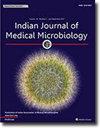Carbapenem-resistant Acinetobacter baumannii: prevalence, phenotypic and genotypic analysis in cases of ventilator associated pneumonia from a teaching hospital in Delhi, India
IF 1.4
4区 医学
Q4 IMMUNOLOGY
引用次数: 0
Abstract
Background and objectives
The high prevalence of multi drug resistant and carbapenam resistant Acinetobacter baumannii(CRAB)is a serious concern for patient management. The most common mechanism of carbapenamresistance is the presence of different types of carbapenamaseenzymes. The type of carbapenamase present affects the optimization of treatment. In this study, we aimed to investigate the prevalence of carbapenem resistance and characterize the genetic mechanisms associated with antimicrobial resistance in Acinetobacter baumannii isolates.
Materials and methods
All clinical isolates of CRAB from ventilator associated pneumonia were included in this study. Clinical, phenotypic, and genotypic data were collected, including clinical details, identification, antimicrobial susceptibility testing, phenotypic detection of carbapenemase activity, biofilm formation assay, and molecular identification of carbapenemase genes like blaOXA-23,blaNDM-1,blaVIM-1 and AmpC.
Result
The blaOXA-23-like gene was detected in 97 % (97/100) of CRAB isolates followed by AmpC (21/100,21 %), blaNDM-1(10/100,10 %) and blaVIM-1 in 6 % (6/100) of isolates. The mortality rate among MBL-positive patients was found to be 67 % (65/97). Furthermore, all Acinetobacter baumannii isolates exhibited biofilm-forming capacity, with varying degrees of biofilm production.
Conclusion
There is high prevalence of carbapenamase enzymes in CRAB isolates. The high detection of blaOXA-23-like, AmpC, blaNDM-1, and blaVIM-1AmpC underscores the urgency to enforce infection control measures and optimize antimicrobial stewardship practices to prevent cross transmission of the organism. Further presence of biofilm formation in almost all the isolates reiterates the need for innovative strategies to combat persistent infections by this organism.
耐碳青霉烯鲍曼不动杆菌:印度德里一家教学医院呼吸机相关性肺炎病例的患病率、表型和基因型分析
背景与目的鲍曼不动杆菌(Acinetobacter baumannii, CRAB)多药耐药和耐碳青霉烯类药物的高发是一个严重困扰患者管理的问题。碳青霉烯抗性最常见的机制是存在不同类型的碳青霉烯酶。存在的碳青霉烯酶类型影响处理的优化。在这项研究中,我们旨在调查鲍曼不动杆菌分离株碳青霉烯类耐药性的流行情况,并表征与抗生素耐药性相关的遗传机制。材料与方法本研究纳入所有呼吸机相关性肺炎的临床分离株。收集临床、表型和基因型数据,包括临床详细资料、鉴定、药敏试验、碳青霉烯酶活性表型检测、生物膜形成试验、碳青霉烯酶基因blaOXA-23、blaNDM-1、blaVIM-1和AmpC的分子鉴定。结果97%(97/100)的螃蟹分离株中检出blaoxa -23样基因,其次是AmpC(21/100,21 %)、blaNDM-1(10/100,10 %)和blaVIM-1(6/100)。mbl阳性患者的死亡率为67%(65/97)。此外,所有鲍曼不动杆菌分离株均表现出生物膜形成能力,并具有不同程度的生物膜生成能力。结论螃蟹分离株中碳青霉酰胺酶含量较高。blaOXA-23-like、AmpC、blaNDM-1和blaVIM-1AmpC的高检出强调了加强感染控制措施和优化抗菌药物管理实践以防止细菌交叉传播的紧迫性。在几乎所有分离株中进一步存在生物膜形成,重申需要创新策略来对抗这种生物的持续感染。
本文章由计算机程序翻译,如有差异,请以英文原文为准。
求助全文
约1分钟内获得全文
求助全文
来源期刊

Indian Journal of Medical Microbiology
IMMUNOLOGY-
CiteScore
2.20
自引率
0.00%
发文量
154
审稿时长
73 days
期刊介绍:
Manuscripts of high standard in the form of original research, multicentric studies, meta analysis, are accepted. Current reports can be submitted as brief communications. Case reports must include review of current literature, clinical details, outcome and follow up. Letters to the editor must be a comment on or pertain to a manuscript already published in the IJMM or in relation to preliminary communication of a larger study.
Review articles, Special Articles or Guest Editorials are accepted on invitation.
 求助内容:
求助内容: 应助结果提醒方式:
应助结果提醒方式:


